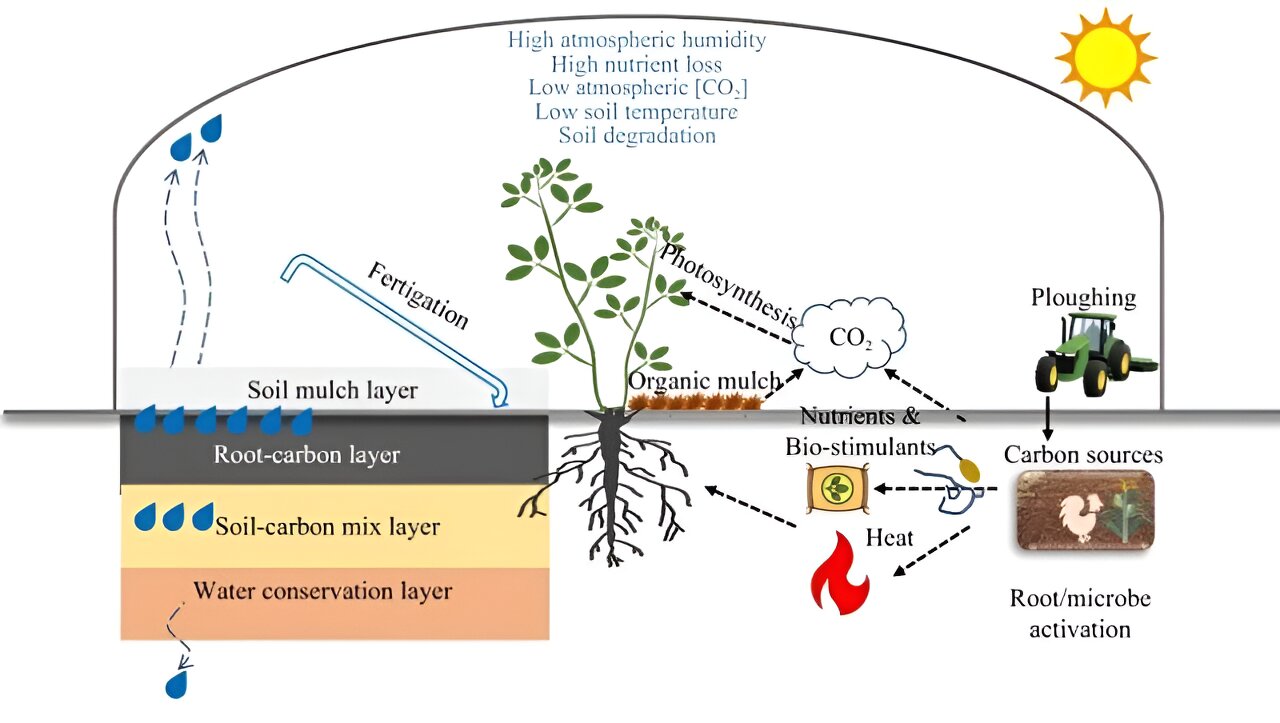

A research team has developed a novel conceptual framework for designing plastic-greenhouse soil profiles that cater to the needs of smallholder farmers. The soil profile includes four functional layers: a soil mulch layer for preventing evaporation, a root-carbon layer for nutrient, CO2, and heat generation, a soil-carbon mix layer for buffering and nutrient supply, and a water conservation layer to store water and nutrients.
Exemplified by the sand mulching in Almería, Spain, and the sunken profile in Shouguang, China, this affordable and sustainable profile design holds significant promise for enhancing horticultural production globally. Future research will focus on adapting these profiles to local conditions and optimizing organic input to improve both plant and soil health, ultimately supporting sustainable agricultural practices.
Plastic greenhouses, including high tunnels and solar greenhouses, play a crucial role in protecting horticultural crops from various stresses, enabling year-round production. These greenhouses, covering 4.8 million hectares globally, create unique microclimates for Anthrosols, which differ markedly from open-field soils.
Despite their economic benefits, plastic-greenhouse soils often suffer from severe degradation due to intensive agrochemical use, leading to soil acidification, salinization, and increased greenhouse gas emissions. Alternative methods like soilless substrates or hydroponic systems offer high yields but are cost-prohibitive for many smallholders. There is an urgent need to understand and design cost-effective soil profiles for these environments to enhance sustainability and support the livelihoods of smallholder farmers.
A study published in Vegetable Research on 2 April 2024, aims to address the unique requirements of plastic-greenhouse soils.
In this study, a detailed design of a soil profile was applied, and structured to optimize conditions for horticultural growth. This profile consists of four distinct layers: a mulch layer to prevent evaporation and regulate humidity; a root-carbon layer designed to receive carbon-containing compounds for generating nutrients, CO2, and heat; a soil-carbon mix layer serving as a buffer to store nutrients and water, while also decomposing toxic metabolites; and a water conservation layer designed to retain water and nutrient and reduce leaching.
Each layer has been tailored to address specific challenges faced by plants in plastic-greenhouse environments, such as lower temperatures, high humidity, and nutrient loss. And the depth of these four layers depends on the specific requirements of a local soil and climate. Two typical examples of this concept were summarized, the sand mulching profile in Almería, Spain and the sunken profile in Shouguang, China. The design effectively utilizes local resources like manure and clay, making it cost-effective and suitable for smallholder farmers.
In Almería, the use of manure and sand mulching has proven successful in enhancing soil warmth and nutrient availability, leading to higher profitability compared to more technology-intensive soilless cultures. Similarly, the sunken profile in Shouguang leverages local clay to create a beneficial microclimate for root development and moisture retention, significantly reducing nutrient leaching compared to traditional open-field systems.
Jinlong Dong, the study’s lead researcher, says, “This soil profile design is affordable and cost-effective for smallholder farmers to produce horticulture product sustainably, therefore, it is worth being applied worldwide.” This innovative approach to soil management in plastic greenhouses underscores the importance of adapting agricultural practices to local conditions while enhancing sustainability and productivity.
More information:
Jinlong Dong et al, How to design cost-effective soil profiles in plastic greenhouses?, Vegetable Research (2024). DOI: 10.48130/vegres-0024-0010
Provided by
Chinese Academy of Sciences
Citation:
Plastic-greenhouse agriculture: A novel soil profile design for global sustainability and enhanced crop production (2024, May 20)
retrieved 21 May 2024
from https://phys.org/news/2024-05-plastic-greenhouse-agriculture-soil-profile.html
This document is subject to copyright. Apart from any fair dealing for the purpose of private study or research, no
part may be reproduced without the written permission. The content is provided for information purposes only.

